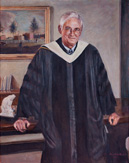Robert H. Edwards (1990–2001)

Robert Hazard Edwards was inaugurated as the thirteenth president of Bowdoin College in October of 1990; he retired as president in June 2001.
During President Edwards' administration significant changes were implemented in both the governance of the College and the residential life of the students. In 1995 the Governing Boards voted to end the bicameral governance system of Trustees and Overseers which had been in place since the establishment of Bowdoin and to merge all Boards members into a single Board of Trustees. And in 1996, following the report of a Commission on Residential Life, the Trustees voted to phase out fraternities, immediately terminating the recruitment of new members, and to abolish fraternities entirely by 2000. The College acquired all fraternity chapter houses by the summer of 2000, to be absorbed after renovation into the college's new residential house system.
The Edwards administration was also notable for financial initiatives beginning with a three-year period of cutting costs, balancing the budget, reducing the draw from endowment and restoring competitive faculty salaries. Subsequently, in 1994, the College embarked on a four-year, ten percent expansion of the student body in order to finance a proportionate increase in faculty size and two new residence halls. The same year a capital campaign was launched to raise $135 million, primarily for science buildings, theater, student social space, faculty chairs, and financial aid endowment. It concluded in 1998 having raised $136 million.
In the economic prosperity of the late 1990s Bowdoin continued to expand its faculty, its facilities, and its student body. Between 1990 and 2001 the student body increased from 1400 to 1610, and the faculty from 130.3 to 154.8. Academic buildings constructed or renovated during President Edwards' tenure included Druckenmiller, Cleaveland and Searles Halls, Memorial Hall and Wish Theatres, Hawthorne Longfellow Library and the Coastal Studies Center. On the social and residential side, the David Saul Smith Union was built inside the former Hyde Cage and Stowe, Howard, and Chamberlain residential halls were constructed, as were the Watson Fitness Center and the Thorne dining complex. Several new programs were established during this administration including the Educational Technology Center, the Learning and Teaching Center, the Off-Campus Studies office, and the Coastal Studies Program. Academic program expansion focused on interdisciplinary endeavors such as Asian Studies, Africana Studies, Environmental Studies, and Women's Studies.
During his presidency, Edwards served as a trustee of Maine Public Broadcasting, trustee of the Maine Science and Technology Foundation, Chair of the Maine Mathematics and Science Alliance, member of the Advisory Committee to the Education and Human Resources Directorate of the National Science Foundation, member of the Governor's Task Force on the Maine Learning Technology Endowment, member of the Board of Visitors of the University of Maine, trustee of Maine Health, and trustee of Aga Khan University. In 2000 he was elected to the American Academy of Arts and Sciences.
Robert H. Edwards died in Newcastle, Maine, on November 30, 2025. He is survived by his daughters, Elizabeth “Eliza” Hazard Edwards and Daphne Hazard Edwards, and by his grandsons, Oliver Skye Rodgers, Dominic Dylan Delong-Rodgers and his wife, Autumn, and by his sister, Barbara Edwards Hicks, and her husband, Paul. He was predeceased by his wife, Blythe Bickel Edwards, in 2024, and by his son, Nicholas Hazard Edwards, in 2011.
Painting credit: Bowdoin College Museum of Art, Brunswick, Maine Commissioned by Bowdoin College; Transferred to Museum Collection, 2001